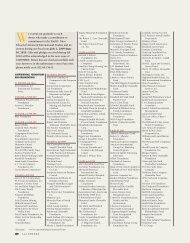Download Current Issue - SAIS
Download Current Issue - SAIS
Download Current Issue - SAIS
You also want an ePaper? Increase the reach of your titles
YUMPU automatically turns print PDFs into web optimized ePapers that Google loves.
discover that conflict causes food insecurity—especially<br />
in the many areas<br />
afflicted with these conflicts. Effective<br />
processes of conflict resolution emerge<br />
as an important element in reversing<br />
world hunger and its companion, environmental<br />
destruction.<br />
Tabitha Grace Mallory focuses on<br />
the important topic of global fisheries<br />
as a huge food source. China is the<br />
world’s largest producer of seafood<br />
and provides an excellent case study<br />
in policies relating to near seas, distant<br />
seas and the industry of aquaculture.<br />
The international law and institutional<br />
framework for managing the oceans’<br />
resources emerges as a crucial component<br />
of any strategy for building our<br />
renewable resources from the sea.<br />
In traditional land farming, depletion<br />
of groundwater is a universal concern.<br />
Srinivasan Padmanabhan points<br />
to the destructive cycle of waste in the<br />
way Indian agriculture is supported by<br />
overuse of subsidized and unreliable<br />
<strong>SAIS</strong> graduate Robert Tetro ’71<br />
captured this image of a<br />
Thai woman transplanting rice.<br />
electricity to pump freshwater at rates<br />
that lead to unsustainable declines in<br />
groundwater levels. The “iron triangle”<br />
of agriculture, water and energy is badly<br />
mismanaged in a system that traps a<br />
large percentage of the rural population<br />
in poverty.<br />
Rising fossil fuel prices are driving<br />
a greater reliance on biofuels. Charles<br />
Pearson discusses how mandates for<br />
biofuels can lead to the double jeopardy<br />
of global warming and reduced food<br />
supply. Although there is no definitive<br />
answer to how much damage is being<br />
done, we know enough to enhance our<br />
agriculture with a much more selective<br />
approach to biofuels policy.<br />
Guy Pfeffermann and Nora Brown<br />
look at the links in the value chain of<br />
agriculture in Africa and their major<br />
impact on the manufacturing, service<br />
and export sectors. With development<br />
aid shifted away from agriculture,<br />
agribusiness offers great opportunities—especially<br />
if a new generation<br />
of agribusiness entrepreneurs and<br />
managers receive the business education<br />
they need.<br />
Michael Plummer and Dalila<br />
Cervantes-Godoy review the economic<br />
literature to demonstrate the centrality<br />
of agricultural development to<br />
growth that, in turn, lessens poverty.<br />
Historically, higher productivity correlates<br />
closely with a greater reduction in<br />
poverty. The transmission mechanisms<br />
include effects both direct and indirect<br />
(economic activity outside the sector).<br />
The goal of food security is best attained<br />
through increased income for the poor<br />
from sources other than agriculture.<br />
In the coming years of this new<br />
century, food geopolitics is poised to<br />
outrank energy politics as a source of<br />
national security concerns. Mariano<br />
Turzi enumerates the demographic<br />
changes that have pushed the world into<br />
a “new age of geopolitical competition,”<br />
as countries whose demand for food<br />
outstrips supply seek other ways to provide<br />
food security to their populations.<br />
Finally, Ruth Wedgwood and Tiffany<br />
Basciano survey the international covenants,<br />
codes and guidelines that apply<br />
human rights criteria to judging foreign<br />
investment in large-scale agriculture,<br />
particularly in Africa. They note that<br />
even where standards are not legally<br />
binding, the “practical cost of disregard”<br />
needs to be calculated.<br />
As I look back on past editions of<br />
<strong>SAIS</strong>PHERE, I congratulate all my colleagues<br />
at <strong>SAIS</strong>. Each year, the themes<br />
have been well chosen, and together<br />
they have helped us understand the rich<br />
landscape of international relations in<br />
what we still call “the new century.” In<br />
addition, the magazine showcases the<br />
relevance of the <strong>SAIS</strong> intellectual tradition<br />
through the perspectives of our faculty,<br />
graduates and students. I know of<br />
no other alumni publication that takes<br />
its articles and the care with which they<br />
are presented to the community more<br />
seriously, and <strong>SAIS</strong>PHERE is consistently<br />
recognized as the best in its class.<br />
As we observe the “Year of Agriculture,”<br />
this issue of <strong>SAIS</strong>PHERE is one of<br />
our “fruits”—a colorful and enlightening<br />
gift of our community. I look forward<br />
to future editions and thank you<br />
for your support. n<br />
2011–2012 5



